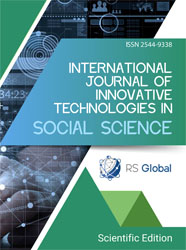THE MANAGEMENT OF URBAN SPACE BETWEEN THE CONFLICT OF ACTORS AND FILED REALITY, CASE STUDY: KHENCHELA PROVINCE – AN INLAND CITY IN THE EAST OF ALGERIA
Abstract
The demographic explosion of Algerian cities by a positive natural balance and population migration movements transforms urban landscapes and leads them to growing environmental pressure.
The resulting spatial increase is more or less planned. It does not only characterize large cities or capitals. The so-called medium-sized cities are also affected, if not more, because they rarely have the assets of large cities to exercise planning and control.
The growth of these urban centers has several effects: densification of the fabric, change of urban areas preserved or associated with specific functions, and progress towards agricultural or natural areas.
Because it leads to increasing needs for housing and services, growth is reflected in the anarchic extension of the urban area on one hand, and in the appearance of unprompted urban houses on the surroundings of cities.
Based on the general hypothesis that urban spatial forms can be analysed using available and supposedly reliable divisions, we attempted to analyse some divisions of Khenchela Province. Our analysis focused on identifying the forms that favour the indications (organizations, directions, temporality, etc.) they provide and the constitution of forms of these divisions.
The objectives of the delimitation of urbanization zones (sectors, districts, boroughs) aim to ensure the achievement of the spatial planning orientations from which the objectives are significant. Spatial organization must contribute to the quality of life of the inhabitants, including future generations. (Christophe, 1998)
The reaction concerning the organization of the different functions (housing, economic activities, shops, leisure facilities, transport infrastructures, etc.) indeed affects everyone's living environment. It can have considerable consequences in many areas directly related to Khenchela Province inhabitants.
References
BAILLY, A. (1995). les representations en geographie . Paris: Economica.
BARBARINO-SAULNIER, N. (2002). De la qualité de vie au diagnostic urbain, la cas de la ville de Lyon.
BRUNET, R. (1997). Territoire : l’art de découpe. Revue de géographie de Lyon Année, volume 72 Numéro 3 p.251-255.
BRUNET, R. (1997). Territoire : l’art de découpe, . Revue de géographie de Lyon, volume 72 Numéro 3 p.251-255.
Christophe, D. (1998). Territoire,qualité de vie et bien-etre social. Wallonie au future.
Dauphiné, A. (1988). les transformations d’un espace régional. Revue d’Analyse spatiale, quantitative et appliquée, Nice, n° 25, p. 3-9, 2.
GEORGE, P. (1974). Espèces d'espaces . Paris: Edition le minuit.
GHORRA-GOBIN. (1997). L a legitmité d'une reéfinition du territoire :citoyennté et culture civique ,analyse critique urbain Americain . revue de geographie de lyon , Volume 72 N° 3 p 233-237.
Gini, C. ((1884-1965).). Initiation de statistique en géographie ed. Rome.
HILGERS, M. (2000). Vers le développement durable des quartiers. . rapport publié dans le cadre des EGEC.
l’environnement, D. d. (2008). Direction de l’environnement de Khenchela2008. Khenchela.
MORALES, E. (1993). Les formes de croisement urbain. Barcelona: Edition Barcelona UPC Catalonia.
OCDE. (1997). Mieux comprendre nos villes. Le rôle des indicateurs urbains,. Paris: Collection développement territorial. OCDE.
ONS. (2008). Recensement generale de la population et de l'habitat. Constantine.
Pinchemel, P. e. (1997). la face de la terre. 1997: Armand colin..
SAUNIER, P.-Y. (1997). Variation autour d’un mauvais sujet : des circonscriptions administratives à Lyon au XIX siècle, Année ,. revue de géographie de Lyon , volume 72 Numéro 3 p.167-171.
VARNIER M, F. G. ((1997).). Les limites du territoire : regard de géographes élus locaux , . Revue de géographie de Lyon, Volume 72 Numero3 p.239-249.
Views:
158
Downloads:
89
Copyright (c) 2024 Djebnoune Brahim, Guendouz Berrehail, Messaoud Inasse, Rachi Sana

This work is licensed under a Creative Commons Attribution 4.0 International License.
All articles are published in open-access and licensed under a Creative Commons Attribution 4.0 International License (CC BY 4.0). Hence, authors retain copyright to the content of the articles.
CC BY 4.0 License allows content to be copied, adapted, displayed, distributed, re-published or otherwise re-used for any purpose including for adaptation and commercial use provided the content is attributed.















